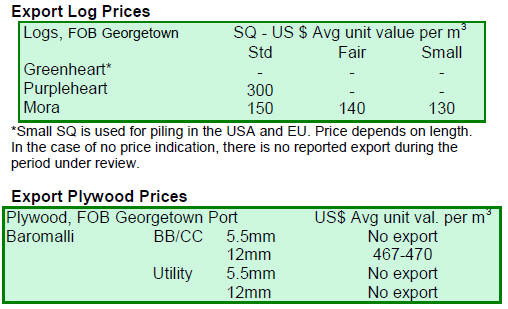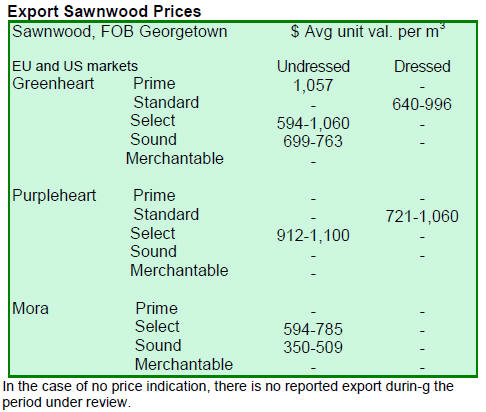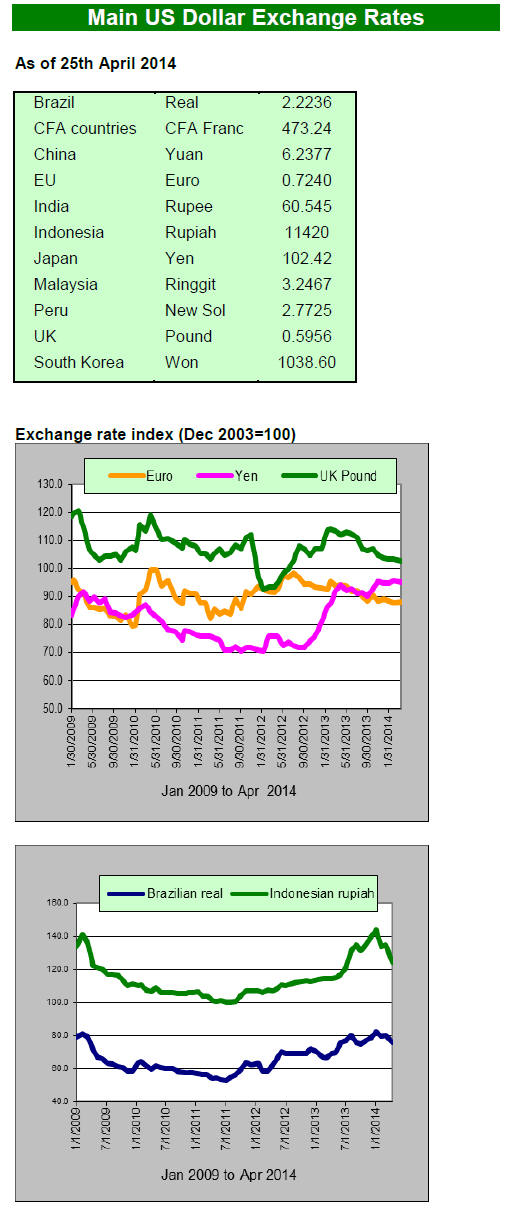2. GHANA
Bold initiative to strengthen Ghana
Forestry
Commission
To improve oversight of the sector the Forestry
Commission (FC) an eleven member committee has been
tasked with recommending ways in which the FC can
better ensure the it its functions in a credible, transparent
and independent manner.
Inaugurating the committee, known as the Timber
Validation Committee (TVC) the Minister for Lands and
Natural Resources, Alhaji Inusah Fuseini, lamented the
inadequate and weak laws that have been the root cause of
illegal forestry operations in the country.
The Minister tasked the TVC with recommending
additional measures to improve the verification and
validation of licenses and for addressing complaints in
ways that eliminate the risk of any outside interference or
influence.
The committee is also responsible to come up with ways
to inform consumers of their rights, obligations and
understanding of the functioning of the Legality Assurance
System (LAS).
Alhaji Fuseini called on stakeholders and the public to
contribute to good governance in the forestry sector.
Tax hike on domestic sales by companies in the Free
Trade Zone
Sales into Ghana‟s domestic market by companies
enjoying the benefits of the Free Zone Enterprises (FZE)
will now attract a 25% sales tax, up from the previous 8%.
Timber companies within the Free Zones will likely raise
the prices of products for the local market when the higher
tax rate is introduced. It is estimated that around 30% of
the output of timber companies in the free zones are sold
into the domestic market.
According to a statement from the tax policy unit of the
Ministry of Finance this change is aimed at ensuring
equity in the payment of taxes between FZEs and the local
industry.
Power shortages soon to be a thing of the past
Mr. Kofi Ellis, Director, Planning and Business
Development at the Volta River Authority (VRA), has said
gas supplies from Nigeria have picked up from a low of 50
to around 100 mi. cubic feet per day, inching closer to the
120 mil.contracted. Mr. Ellis said he expects the power
supply in Ghana to normalise by the end of April when all
power plant maintenance has been completed.
Inflation above government target
Ghana's annual inflation rate reached a four-year high of
14.5 percent in March up from 14.0 percent in February
largely because of increases in house prices and water and
electricity rates. The latest rise has lifted the rate past
target 9.5 percent (+/- 2 percent) set by the government for
2014.
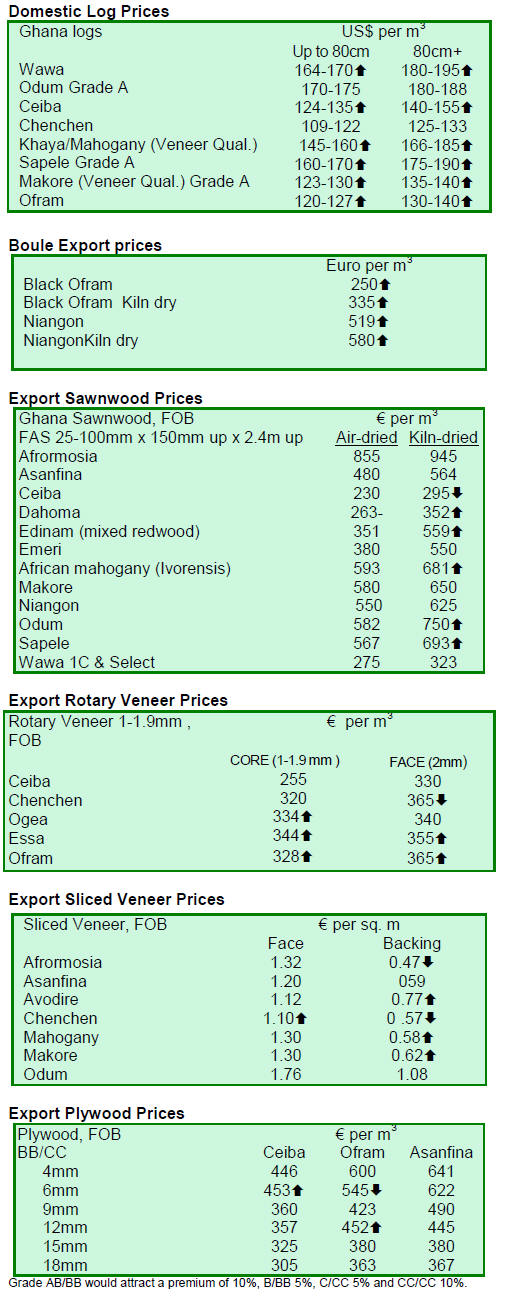
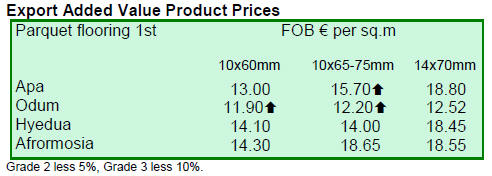
3. MALAYSIA
Exports picked up from start of 2014
The Malaysian Timber Industry Board (MTIB) released
data on exports from January 2013 to January this year.
Exports of sawnwood, fibreboard and particleboard picked
up in the early part of the year while exports of plywood
and mouldings remained flat throughout the year.
At the beginning of the third quarter sawnwood,
fibreboard and particleboard exports fell away and January
2014 exports of these three products were well below
levels a year earlier.
January 2014 wood product exports from Peninsular
Malaysia totalled 145,971 cu.m out of which Port Klang,
the closest port to Kuala Lumpur, handled the most at
87,851 cu.m (60% of all exports). Kuantan Port handled
9,352 cu.m; Pasier Gudang 15,770 cu.m; Tanjung Pelepas
10,180 cu.m and Penang 22,818 cu.m.
Malaysian imports of bamboo products six to eight
times higher than exports
The MTIB is promoting the potential of bamboo in an
effort to boost the bamboo industry in the country.
Malaysia‟s exports of bamboo products over past 10 years
were valued at only RM 250,000 (approximately US$
75,000) while imports of bamboo products, mainly from
China, Indonesia and Thailand, were six to eight times
higher than exports.
According to the International Network for Bamboo and
Rattan (INBAR), the international bamboo trade is worth
around US$18 billion a year and rising.
Malaysia has a 10 year action plan to develop the bamboo
industry and intends to focus efforts on:
Establishment of bamboo plantations and
preservation of existing natural resource
management.
Human capital development.
Development of downstream activities.
Research and development.
Marketing and promotion.
Fears that Korea may reintroduce anti-dumping duties
on Malaysian plywood
Sarawak plywood exporters are worried that South Korean
authorities may extend anti-dumping duties on imports of
Malaysian plywood.
The current round of duties ended in February this year
but now the Korean Trade Commission is conducting a
review to determine if they should be
reintroduced.
The duties on Malaysian plywood imports into South
Korea which were imposed in March 2011 ranged from
5% to 38% depending on the supplier and applied to
panels of 6mm and above.
The duties took a heavy toll on Sarawak‟s plywood
exports to South Korea. In 2013, Sarawak exported 266,00
cu.m of plywood compared to the 331,600 cu.m in 2012.
In 2010, before the duties were imposed, Sarawak
exported around 530,000cu. m of plywood to South Korea.
Forest Watch initiative for quick response to illegal
activities
Transparency International Malaysia has launched a Forest
Watch Initiative in Sarawak which allows for individuals
or representatives of forest communities to report
suspected illegal forest operations.
Forest Watch has established a website providing satellite
imagery and a GIS capacity so areas where there is a
suspicion of wrongdoing can be pinpointed.
Reports that are lodged with the system are examined by a
task force comprising of officials from the Sarawak
Forestry department, the Malaysian Anti-Corruption
Commission, Institute of Foresters Malaysia, and
Transparency International Malaysia and action is taken
when necessary.
¡¡
4. INDONESIA
Costs and shortage of assessors hindering
SVLK
implementation
At a recent gathering to discuss the implementation of
Indonesia‟s timber legality assurance system (SVLK),
Bibi Fatmawati of Yogya Indo Global exports said
securing SVLK certification costs at least US$2,000 and
that this bars many smaller enterprises from applying for
certification.
Costs are one issue said WWF Indonesia‟s director of
policy and transformation, Budi Wardhana, but the lack of
a standard cost structure for the certification is another
hurdle. He said the charges for SVLK assessment vary
widely with no clear rationale for the various price
structures.
According to Budi, the low number of SVLK assessors is
also a stumbling block for the government as it pushes
ahead with SVLK.
Several analysts have said that Indonesian officials need to
focus on developing consistent standards for the SVLK
and FLEGT-VPA, on capacity building for local officials
and businesses and on developing a complete chain of
accountability.
Arguments for and against lifting log export ban
A group of wood product manufacturers is strongly
opposed to the government‟s plan to resume log exports
fearing this will result in a shortage of raw materials for
local companies.
The chairman of the Indonesian Furniture and Handicraft
Association (AMKRI ¨C Assosiasi Mebel & Kerejinan
Indonesia) Soenoto said logs contributed about 40 percent
of the total production cost so a shortage leading to higher
log costs would push up production costs significantly.
He stressed that at the end of 2011 the export of raw rattan
was banned to support local companies and that this
resulted in a sharp increase in exports of rattan products.
Data from Sucofindo, an independent surveyor in
Indonesia, shows that between January and March this
year rattan product exports grew by around 30 percent
year-on-year to US$48 million.
Indonesia's log export ban followed the massive outflows
of logs between 1998 and 2001 when the export tax was
sharply reduced and the ban has helped domestic industry.
While the proposal to lift the log export ban has met
opposition from several ministries concerned on the
impact on domestic manufacturers discussions on the issue
continue.
Industry minister Mohammad Suleman Hidayat, has
revealed that timber companies in Papua are in favour of
lifting the ban which, they say, is part of the reason why
unemployment in the province is high.
Exhibition of top rate furniture from SVLK certified
companies
Indonesia‟s Timber Legality Verification System (SVLK)
is likely to boost exports of wood products to the
European Union.
To promote the wider adoption of the SVLK an exhibition
of furniture from SVLK certified companies was hosted
by WWF Indonesia, the Indonesian Furniture
Entrepreneurs Association (Asmindo), the Indonesia
Furniture Designers Association (HDMI) and the EU.
As part of the exhibition, nine small and medium
enterprises (SMEs) from Java displayed SVLK-certified
products at the recent WWF SWICTH-ASIA booth at the
International Furniture and Craft Fair Indonesia (IFFINA)
in Jakarta.
WWF Indonesia and Asmindo have been helping furniture
SMEs understand and secure SVLK certification through
training and intensive interaction with furniture SMEs.
Dita Ramadhani, the trade and networking coordinator for
WWF Indonesia, said WWF and Asmindo had selected the
best businesses from their SME Switch-Asia Program
participants for a special exhibition of furniture designs
made from SVLK certified wood.
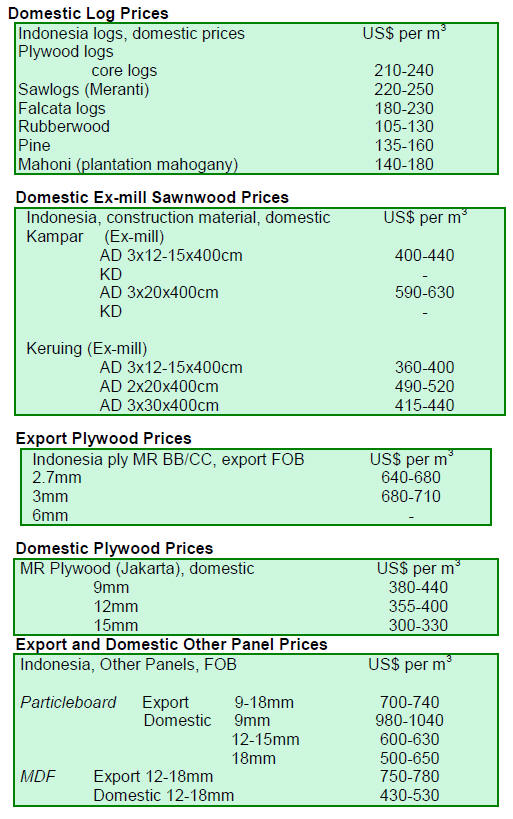
¡¡
5. MYANMAR
Aftermath of the log export ban
The export trade for Myanmar timbers became very quiet
after the 31 March coming into force of the log export ban.
A substantial volume of logs purchased for export was not
shipped before the deadline and remains in Yangon depots
but the Myanma Timber Enterprise (MTE) has yet to
determine the exact unshipped volume.
Observers say that companies with huge volumes of
unshipped logs are considering a petition to the authorities.
The MTE is saying it began advising exporters to clear
logs quickly once it became clear in October 2012 that the
ban would be implemented.
Analysts point out that factors such as the weak Indian
rupee, high stocks and congested log-yards in India and
tight financing hindered prompt shipments to India, the
main market for Myanmar logs. It was only in October
2013 that export shipment started to rise, peaking in
March 2014. Export shipments of logs for the 2013-14
financial year were around 661,000 cubic metres of teak
logs and 2,013,000 cubic metres of other hardwoods.
Analysts say around 50% of the years‟ teak logs and
46%
of the total hardwood logs were shipped out in just the last
quarter of the financial year (January to March).
As the regulations stand at present, unshipped logs will
have to be processed locally after which products meeting
the required level of processing could be exported.
Analysts anticipate lower log prices in upcoming auctions
because of the large volumes that will be for sale.
However, once the stock of unshipped logs are utilised
prices will better reflect mill requirements for the domestic
and international market. Looking ahead, the plan by
MTE‟s to reduce annual log harvests will likely firm up
log prices.
Illegal overland transport of timber
Overland transport of illegal harvested Tamalan
(Dalbergia oliveri) increased during 2014 according to
Myanmar Customs officials. In early April six trucks
attempting to carry Tamalan logs to a neighbouring
country were stopped.
Reports suggest that Tamalan is in great demand in China
and can fetch prices up to Myanmar kyats 70,00,000
(roughly US$7000) per ton.
According to Forestry Department officials and the
Auditor General‟s office about 35,000 tons of illegal
timber was seized during in the last 9 months of the fiscal
year.
The high incidence of illegal logging of Tamalan and
Padauk is raising concerns in Myanmar of the danger that
these species may become endangered.
Investment from China nosedives
The local media has reported that China‟s investment in
Myanmar fell sharply in 2013 to only US$20 million or
just 5% of the investment reported in 2012 and only 1% of
the investment in the peak year of 2010.
Past log tender prices
The following regular items were sold by competitive
bidding at the most recent sale (10 and 21 March 2014) at
the Myanma Timber Enterprise (MTE) tender hall. Details
of the end April auctions are not yet available.
Teak sales
The following grades were sold by competitive bidding on
10 and 21 March 2014 at the Myanma Timber Enterprise
(MTE) tender hall.
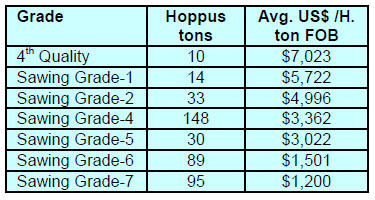
6.
INDIA
Wholesale Price Index rises stoking fears
of further
inflation
The Office of the Economic Adviser (OEA) to the Indian
government provides trends in the Wholesale Price Index
(WPI). The official Wholesale Price Index for „All
Commodities‟ (Base: 2004-05 = 100) for March 2014 was
up just under 1 point to 179.8.
On inflation a press release from the OEA says ¡° The
annual rate of inflation, based on monthly WPI, stood at
5.70% (provisional) for the month of March 2014 (over
March 2013) as compared to 4.68% (provisional) for the
previous month and 5.65% during the corresponding
month of the previous year.
For more see: http://www.eaindustry.nic.in/cmonthly.pdf
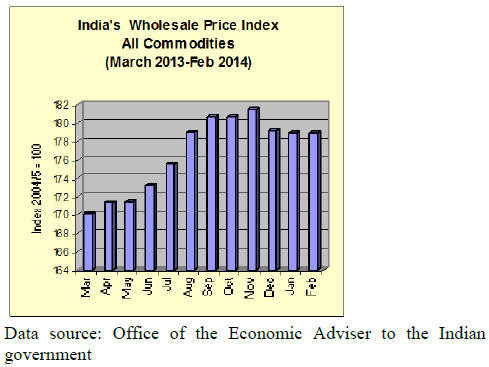
The March increase in the WPI was driven largely by
rising food prices. The latest numbers have analysts
concerned that the Reserve Bank of India (RBI) will delay
lowering interest rates which, say industrialists, is holding
back economic growth.
Data show that March fuel prices were up over 10% year
on year and that prices for manufactured products also
rose.
The RBI has increased interest rates every month since last
September saying it is more concerned about inflation than
short-term growth prospects.
El nino effect to impact Indian economy
Skymet, a private Indian company that provides weather
forecast and analyses of weather related events on the
Indian economy, has said there is very high probability
that India will see below normal monsoon rains this year
because of the currently developing El Nino in the Pacific
Ocean.
The RBI has also warned that. if the El Nino does result in
poor monsoon rains, agricultural yields will be lower than
normal which could mean higher food prices.
This would trigger higher inflation requiring the
Bank to
increase in interest rates even higher.
For more see: http://www.skymet.net/reports.php and
(http://rbi.org.in/Scripts/BS_ViewBulletin.aspx?Id=14842)
Timber and plywood wholesale price indices
In addition to data on the Wholesale Price Index for all
commodities, the OEA reports wholesale price indices for
a variety of wood products.
The Wholesale Price Indices for Logs/timber and Plywood
are shown below. The March 2014 logs/timber index was
virtually unchanged from February but the plywood index
has moved up sharply.
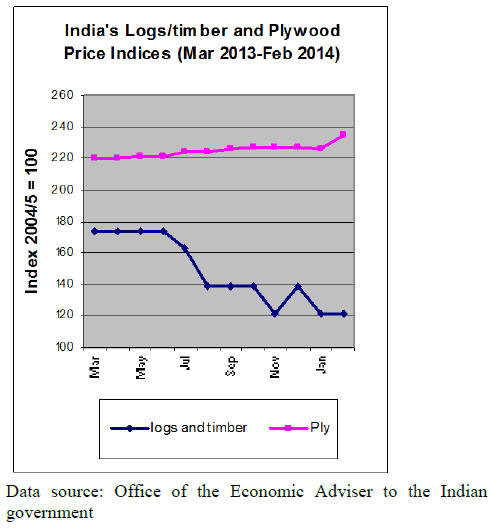
Record prices paid for 500 year old rosewood
Many top rated international guitar manufacturers bid for
the over 500-year-old rosewood on auction at the Indian
Forest Department timber depot at Chaliyam. The
Chaliyam timber depot has been the major supplier of
rosewood for the international market as the wood is
traded only in this state depot.
The depot recently secured logs from one of the oldest
rosewood trees in the Chethalayam range after it was
uprooted in a storm.
The demand for Indian rosewood increased after Brazil
banned the export of Brazilian rosewood. The brilliant
hues of the timber and the density make it one of the best
woods for musical instruments.
Imported teak prices
Current C & F prices for imported plantation teak, Indian
ports per cubic metre are shown below.

Prices for air dry sawnwood per cubic foot,
ex-sawmill are
shown below.
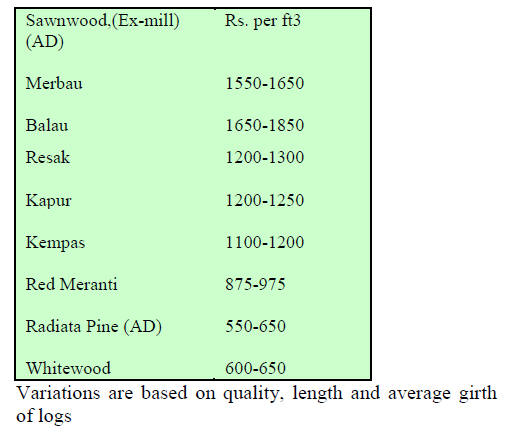
Myanmar teak processed in India
Export demand continues to be good. Indian buyers of
Myanmar teak imported as much as possible before the log
export ban in Myanmar and therefore have high stocks.
Analysts report that domestic demand for teak products is
weak and that prices for sawn teak remain un-changed.
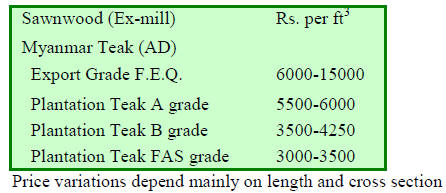
Imported sawnwood prices
Ex-warehouse prices for imported kiln dry (12% mc.)
sawnwood per cu.ft are shown below.


¡¡
7.
BRAZIL
Brazilian real slumps on Central
Bank policy decision
While average prices for wood products in the domestic
market in Brazilian real have not changed over the past
month values in US dollars reflect fluctuation in exchange
rates.
The average exchange rate in March was BRL 2.33 to the
dollar while in March 2013 the rate was BRL 1.98 to the
dollar.
On the 25th April Brazil‟s real fell sharply to 2.244 to the
US dollar, the steepest decline since December last year.
This dramatic fall was triggered by a decision by the
Central Bank not to continue currency swaps which had
supported the recent 5% strengthening of the real.
Diverging forecasts of growth prospects
Brazil‟s Central Bank's most recent index of economic
activity shows that the economy grew 1.63% in February
compared to February 2013. On this basis year-on-year
growth would be 2.41 percent, up from the 2.3% reported
based on January data.
See:
https://www.bcb.gov.br/textonoticia.asp?codigo=3815&ID
PAI=NEWS
The IMF has said that it expects the Brazilian economy to
continue its slow pace of growth in 2014 despite a boost it
may get from hosting the World Cup. The IMF has
forecast growth for the year at 1.8% compared to earlier
estimates of 2.3%.
The IMF also lowered Brazil's 2015 growth forecast
to
2.7% having forecast 2.8% at the beginning of the year.
Interest rates jump to 11 percent
Inflation, as measured by the consumer price index, ended
up almost 1% at the end of March. Over the past 12
months cumulative rate of inflation was 6.15%. In
response to the steep rise in inflation the Monetary Policy
Committee of the Central Bank decided to increase the
Selic rate to 11% per year.
See:
https://www.bcb.gov.br/textonoticia.asp?codigo=3812&IDPAI=
NEWS and
http://www.bcb.gov.br/htms/relinf/direita.asp?idioma=P&ano=2
014&acaoAno=ABRIR&mes=03&acaoMes=ABRIR
New Brazilian forestry sector association
The Brazilian Tree Industry (IBA or Ind¨²stria Brasileira
de Árvores) is the newest association in the Brazilian
forestry sector and is the result of a merger of three major
associations; ABRAF (Brazilian Association of Forest
Plantation Producers), BRACELPA (Brazilian Pulp and
Paper Association) and ABIPA (Brazilian Association of
Wood Panel Industry).
The term IBA, or more correctly Ib¨¢, comes from the Tupi
Guarani language Yb¨¢, which means tree or fruit.
The new association will be formally launched in June
2014, during the environment week and will begin with a
membership of 70 forestry sector companies.
The board of the association has been holding meetings in
São Paulo to discuss guidelines and other strategic issues
with the aim of building a new less conservative image
than the previous associations.
Amazon native species for plantations
A native Amazon tree species, called cuiabano pine,
guapuruvu or paric¨¢ (Shizolobium amazonicum), is gaining
acceptance as a plantation timber in the state of Mato
Grosso. This tree is said to have some advantages
compared to eucalyptus which is commonly planted in
Brazil.
Paric¨¢ grows for around seven years without producing
side branches resulting in a knot free bole. In addition it is
claimed that this timber yields as much as four times more
per hectare than eucalyptus and produces high quality pulp
and good light colour veneers.
Reports indicate that the timber is highly susceptable to
insect and fungal attack and needs to be preservative
treated if used in the soild form.
The timber industry has recognised the potential of this
species because it is light, easy to work and has good
technical charateristics making it suitable for a wide range
of enduses.
Tropical wood product exports continue to slide
In March 2014, wood product exports (except pulp and
paper) increased 9.7% in terms of value compared to
March 2013, from US$199.3 million to US$218.6 million.
Pine sawnwood exports increased 44.6% in value in
March 2014 compared to March 2013, from US$12.1
million to US$17.5 million. In terms of volume, exports
rose 38%, from 54,700 cu.m to 75,500 cu.m over the same
period.
In contrast, tropical sawnwood exports fell 29% in
volume, from 31,900 cu.m in March 2013 to 22,600 cu.m
in March 2014. In terms of value, exports dropped 15.3%
from US$15.7 million to US$13.3 million, over the same
period.
In March pine plywood exports increased almost 13% in
value year on year, from US$32.8 million to US$37
million. Export volumes increased 14%, from 86,500 cu.m
to 98,800 cu.m, during the same period. However, tropical
plywood exports continue to fall and in March this year
exports declined 11% from 4,500 cu.m last year to 4,000
cu.m this year.
Better results were posted for wooden furniture exports
which increased from US$35.7 million in March 2013 to
US$40.7 million in March this year, a 14% increase.
Projection of exports to traditional and new markets
Brazil‟s sawnwood exports to the United States increased
from 70,000 cu.m in 2012 to 86,000 cu.m in 2013
reflecting a recovery of demand. Moreover, exports of
pine plywood to the US also increased, from 40,000 cu.m
in 2012 to 120,000 cu.m in 2013. For 2014 exports of
plywood to the US are expected to be as high as 140,000
cu.m.
According to ABIMCI (the Brazilian Association of
Mechanically Processed Timber Industry) Germany is
now importing more from Brazil as the construction and
housing markets are growing. January pine plywood
exports to Germany totalled 11,106 cu.m and this
increased to 15,092 cu.m in February.
ABIMCI notes that demand seems to be improving in
Belgium, Italy and the United Kingdom.
The European market is seen as offering better prospects
in 2014 as some European plywood producers have either
closed or have, as in the case of Finland, reduced output
due to raw material supply issues. These changes are
opening new opportunities for Brazilain exporters in both
traditional western markets and new markets in Eastern
Europe.
Another region with opportunities for the Brazilian timber
industry is South America. Forecasts from the IMF and
others suggest the economies in countries such as Peru,
Ecuador and Chile will grow in 2014 which will result in
increased consumption of wood products.
SFB creates timber ID tool
The Amazon Cooperation Treaty Organization (ACTO) is
developing an interactive tool with information on the
commercial species in eight ACTO member countries
based on a similar tool developed by the Brazilian Forest
Service (SFB).
The tool that is being developed will be more
comprehensive than the Brazilian ID tool as it will include
genetic information and images of flowers, fruits, bark and
standing trees. The SFB will undertake work on the
description of species. SINCHI (Instituto Amaz¨®nico de
Investigaciones Cient¨ªficas) will perform DNA analysis
and botanical identification of collected samples.
The objective of the development of this interactive tool is
to provide information for environmental agencies, police
officers and experts or researchers for the easy
identification of a timber .
In Brazil, the tool is used by IBAMA (Brazilian Institute
for Environment and Renewable Natural Resources) and
by the Federal Police to identify whether timbers being
transported or processed are species that can be legally
harvested.
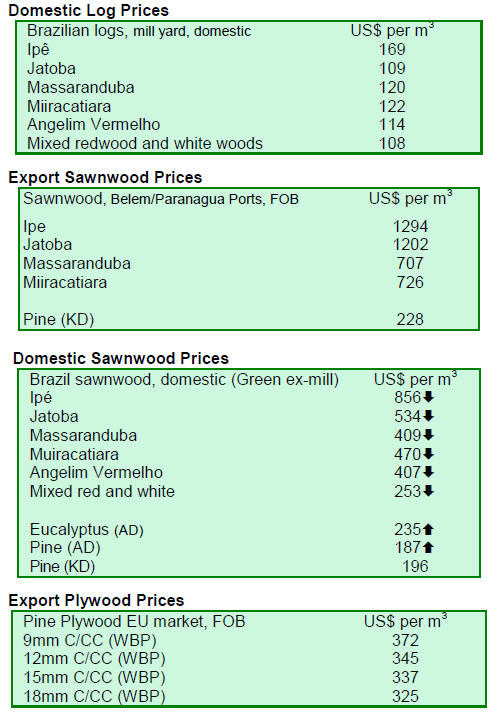
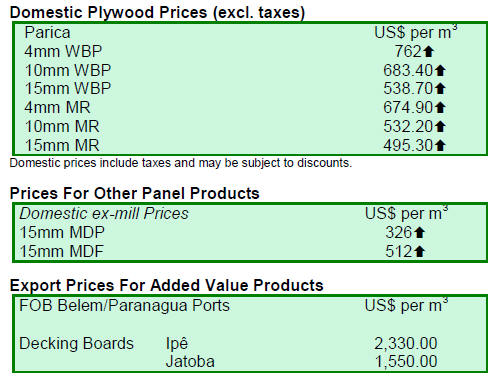
¡¡
8. PERU
Analysing contributions to the Forestry
and Wildlife
regulations
As part of the approval process for the new Forestry and
Wildlife Act, an intergovernmental group held a workshop
to establish criteria for assessing the over 2,000 written
contributions made by concerned groups and individuals.
The workshop was attended by representatives of regional
governments, civil society, NGOs and international
technical cooperation agencies.
The new Forestry and Wildlife Law contains 459 articles
and was submitted for review and public comment in
September last year and there was a huge response from
stakeholders.
To facilitate assessment of the comments and suggestions
the submissions were categorised into those related to
wildlife, forest management and indigenous and rural
communities.
The intergovernmental group was led by the General
Directorate of Forestry and Wildlife, Ministry of
Agriculture and Irrigation and involved the Ministries of
Environment, Foreign Trade and Tourism, Culture,
Production, Economy and Finance, the Presidency of the
Council of Ministers.
Also included was the agency for the Supervision of
Forest Resources and Wildlife (OSINFOR), the
Interregional Amazon Council Amazon (representing
regional governments and appointed by the National
Assembly of Regional Governments) and the Centre for
National Planning. Asessment of the many submissions
will take a considerable time.
Agrobanco exceeded placements during the first
quarter of 2014
Agrobanco has reported that its loans nationwide reached
US$350 million during the first quarter of this year,
exceeding initial projections. The president of the
organization, Hugo Wiener, noted that this is very good
news for the agriculture and forestry sectors.
Wiener said that during 2013 approximately 50,000
agricultural and timber sector enterprises benefitted from
Agrobanco credit and long-term finance.
The highest percentage of loans in 2013 were to finance
production of agricultural crops, forestry, timber
processing and agribusiness.

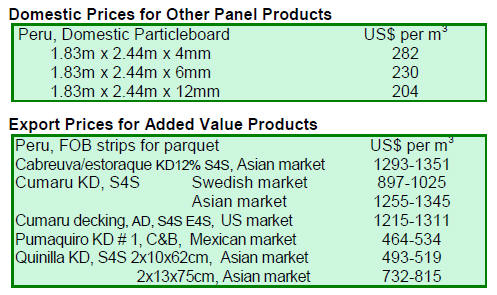
9.
GUYANA
Top three timbers dominate export trade
During the period reviewed there were no shipments of
greenheart logs but purpleheart logs were exported and at
moderately attractive prices. Standard Sawmills quality
purpleheart logs were priced at US$300 per cubic metre
FOB.
Mora logs were sold for a fair price to international buyers
with mora Standard Sawmill quality logs fetching US$150
per cubic metre FOB. Fair Sawmill quality mora attracted
an FOB price of US$140 while Small Sawmill quality
mora logs were traded at US$130 per cubic metre FOB.
Wamara (Swartzia leiocalycina) logs continue to be in
demand and the latest shipments went at prices ranging
from US$120 to US$170 per cubic metre FOB. Guyana‟s
logs continue to attract buyers mainly in the Asian
markets.
Greenheart sawnwood demand firms
Sawnwood exports were encouraging and made a useful
contribution to total export earnings during the period
reviewed. Undressed greenheart (Prime) continues to
maintain a price of US$1,057 per cubic metre FOB.
The FOB price for Undressed greenheart (Select)
remained stable at US$1,060 per cubic metre. The top-end
FOB price for Undressed greenheart (Sound) moved from
US$594 to US$763 per cubic metre. This quality of
greenheart is in demand in Europe, the Middle East and
North America.
During the period reviewed Undressed purpleheart FOB
prices moved from US$1,080 to US$1,100 per cubic metre
for shipments to markets in the Caribbean and New
Zealand.
Undressed mora (Select) sawnwood recorded a significant
price increase, climbing as high as US$785 per cubic
metre FOB while for Sound quality prices were around
US$509 per cubic metre.
In contrast to the price gains mentioned above during the
period reviewed Dressed greenheart sawnwood FOB
prices fell US$1,102 to US$996 per cubic metre, the
Caribbean remains the main market for this product.
Similarly Dressed purpleheart FOB prices eased from
US$1,102 to US$ 1,060 per cubic metre.
Recently plywood prices have also eased from US$578 to
US$470 per cubic metre FOB with the demand coming
mainly from buyers for the Central American markets.
Greenheart piles (Select category) secured a noteworthy
price on the export market and earned as much as US$ 531
per cubic metre FOB in the North American market.
Wallaba poles FOB prices remained unchanged at US$833
per cubic metre in the Caribbean market. However,
Splitwood (shingles) prices were maintained at US$1,045
per cubic metre, up from the previous shipment prices.
Harnessing local building contractors to promote LUS
use
As part of an effort to raise public awareness of the wide
range of timbers available the FPDMC has published a
guide that groups the lesser used species into categories
based on their properties compared to the more commonly
used timbers.
As an example the guide mentions that black kakaralli can
be a substitute for greenheart in many applications ,
morabukea for ora, futui for silverballi whilst darina can
be substituted for locust. The species guide is proving very
popular with local builders and furniture makers.
Homeowners in Guyana have expressed satisfaction with
the performance of tonka bean and darina, both LUS, for
flooring as well as with the performance of korokororo,
another LUS, for ceiling panels and itikiboroballi and
kurokai for wall panels.
In Guyana consumers often seek assistance and guidance
on suitable timbers from building contractors and as such
these specialists are in a position to perform an important
role in promoting the use of a wider range of timbers.
Carpenters and building contractors are now being
encouraged to familiarise themselves on the LUS timbers
that are available.
